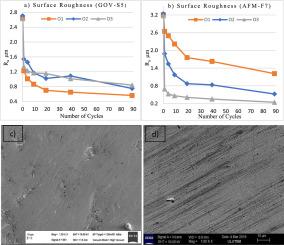铬镍铁合金 718 磨料流加工与流强化 GOV 工艺的对比实验研究
IF 8.3
2区 材料科学
Q1 MATERIALS SCIENCE, MULTIDISCIPLINARY
引用次数: 0
摘要
Inconel 718 是一种镍基超级合金,由于具有高耐久性、耐腐蚀性和高温性能,其应用领域非常广泛,从航空航天、医疗、国防到传统工业都有涉及。磨料流加工(AFM)和喷丸强化(SP)等非常规表面处理方法被用来改善 Inconel 718 的机械性能。在这项工作中,针对 Inconel 718 实验应用了一种新的表面处理工艺,即流动强化 (GOV),它结合了磨料流动加工 (AFM) 和喷丸强化方法的优点,如表面精加工和产生残余压应力。实验研究了 GOV 和 AFM 工艺参数对试样表面质量的影响。讨论了两种工艺的白层减少、表面粗糙度降低和材料去除量。GOV 工艺获得了最佳的表面质量,表面粗糙度值为 0.56 μm Ra,材料去除量为 7.2 mg,而 AFM 工艺去除 6648.03 mg 材料,获得了类似的表面粗糙度值 0.52 μm。当继续使用 AFM 工艺时,与 GOV 工艺相比,在去除 17385.60 毫克多余材料后,获得了 0.24 μm Ra 的最佳值。此外,所有这些结果都得到了 SEM 图像的支持。本文章由计算机程序翻译,如有差异,请以英文原文为准。

A comparative experimental study on abrasive flow machining vs flow peening GOV processes on Inconel 718
Inconel 718, a nickel-based super alloy, has a broad applications area from aerospace, medical and defence to traditional industries because of its high durability, corrosion resistance and elevated temperature performance. Unconventional surface treatment methods of abrasive flow machining (AFM) and shot peening (SP) are applied to improve the mechanical performance of Inconel 718. In this work, a new surface treatment process known as flow peening (GOV) already developed by combining the advantages of abrasive flow machining (AFM) and shot peening methods such as surface finishing and residual compressive stress generation respectively was applied experimentally for Inconel 718. The effects of process parameters for GOV and AFM processes on the surface quality of the specimens were experimentally investigated. White layer decrease, surface roughness decrease and material removal amount were discussed for both processes. The best surface quality with 0.56 μm Ra surface roughness value and material removal amount of 7.2 mg were obtained by GOV process while similar level of surface roughness value of 0.52 μm was obtained by removing 6648.03 mg material for AFM. When the AFM process was continued, the best values of 0.24 μm Ra was obtained removing excess material of 17,385.60 mg compared to the GOV process. Also, all these results were supported by SEM images.
求助全文
通过发布文献求助,成功后即可免费获取论文全文。
去求助
来源期刊

ACS Applied Materials & Interfaces
工程技术-材料科学:综合
CiteScore
16.00
自引率
6.30%
发文量
4978
审稿时长
1.8 months
期刊介绍:
ACS Applied Materials & Interfaces is a leading interdisciplinary journal that brings together chemists, engineers, physicists, and biologists to explore the development and utilization of newly-discovered materials and interfacial processes for specific applications. Our journal has experienced remarkable growth since its establishment in 2009, both in terms of the number of articles published and the impact of the research showcased. We are proud to foster a truly global community, with the majority of published articles originating from outside the United States, reflecting the rapid growth of applied research worldwide.
 求助内容:
求助内容: 应助结果提醒方式:
应助结果提醒方式:


